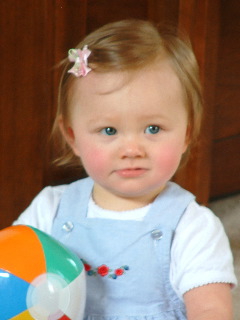For some inexplicable reason, I’m a little bonkers about the history of the British monarchs. More particularly, the history and relationship between Queen
Elizabeth I and Mary, Queen of Scots.
Right now, I find myself in the midst of a re-read of “Mary, Queen of Scots” by Antonia Fraser. Really, the details of Mary’s execution (on the orders of Elizabeth I) are chilling and gruesome and fascinating. Fascinating in a chilling and gruesome way, you see. So in keeping with a good friend’s theory that if you’re reading or watching something gruesome, you absolutely MUST share it in order to purge or even manage the horror in your head, I’ll be sharing portions of this bit of history with you here.
Your turn for the bad dreams.
Don’t say I didn’t warn you.
But it IS interesting. Unless you don’t care for history. Then, I suppose it’s not, really.
(Now some very brief background before you read — Mary had been imprisoned in England for 19 years and was tried illegally — a sovereign of a foreign country tried for treason against a queen to whom she was not subject. But Mary WAS an incredibly divisive figure. Catholics loved her; Protestants hated her. English Catholics considered her the rightful heir of their throne and she DID have a legitimate claim to it. She and Elizabeth I were cousins, both descendants of Henry VII. But Mary, an extremely bright, charismatic women, ruled with her heart, trusted where she shouldn’t have, and lost her life for it. I imagine that one of these women would have HAD to die; the existence of one was too threatening for the other. And, in the end, Elizabeth was the one who kept her head, in more ways than one.)
Anyway, the excerpt. It’s long, but it reads fast, I think. Read through to the end for some rather … unexpected moments. And watch out for that pit-in-your-stomach feeling.
Starting the night before her execution:
She did not try to sleep. Her women gathered round her already wearing their black garments of mourning, and Mary asked Jane Kennedy to read aloud the life of some great sinner. The life of the good thief was chosen, and as the story reached its climax on the cross, Mary observed aloud: “In truth he was a great sinner, but not so great as I have been.” She then closed her eyes and said nothing further. Throughout the night the sound of hammering came from the great hall where the scaffold was being erected. The queen lay on her bed without sleeping, eyes closed and a half smile on her face.
The day now dawned fine and sunny; it was one of those unexpected early February days when it suddenly seems possible that spring will come. It was between eight and nine when a loud knocking was heard at the door and a messenger shouted through it that the lords were waiting for the queen. Mary asked for a moment to finish her prayers, at which the lords outside in a moment of panic feared some sort of last-minute resistance might be planned, unable to believe in the courage of their captive. But when they entered, they found Mary kneeling quietly in prayer in front of the crucifix which hung above the altar.
It was this crucifix which her groom now bore before her as she was escorted towards the great hall. The queen was totally calm and showed no signs of fear or distress. Her bearing was regal, and some of the observers afterwards even described her as cheerful and smiling. The last moment of agony came in the entry chamber to the hall, when her servants were held back from following her and the queen was told that she was to die quite alone, by the orders of Elizabeth. Melville (her steward), distracted at this unlooked-for blow, fell on his knees in tears. The queen dashed away her own tears and said gently: “You ought to rejoice and not to weep for that the end of Mary Stuart’s troubles is now done. Thou knowest, Melville, that all this world is but vanity and full of troubles and sorrows.”
Mary now turned to the lords and pleaded with them to allow at least some of her servants to be with her at the death, so that they could later report the manner of her death in other countries. Kent replied that her wish could not well be granted for before the execution her servants were sure to cry out and upset the queen herself, as well as disquieting the company, while afterwards they might easily attempt to dip their napkins in her blood for relics which, said Kent grimly, “were not convenient.”
“My lord,” replied Mary, “I will give you my word and promise for them that they shall not do any such thing as your lordship hath named. Alas, poor souls, it would do them good to bid me farewell.” After hurried whispered consultations, the lords relented and Melville, Jane Kennedy, and Elizabeth Curle and two others were allowed to go forward with the queen.
Mary now entered the great hall in silence. The spectators gathered there — about 300 of them — gazed with awe and apprehension at this legendary figure whose dramatic career was about to be ended before their eyes. They saw a tall and gracious woman, dressed in black, save for the long, white lace-edged veil which flowed down her back to the ground like a bride’s, and the white stiffened and peaked head-dress, that too edged with lace, below which gleamed her auburn hair. Her satin dress of black was embroidered with black velvet, with black acorn buttons of jet trimmed with pearl; through the slashed sleeves could be seen inner sleeves of purple. She held a crucifix and a prayer book in her hand, and two rosaries hung down from her waist. Despite the fact that Mary’s shoulders were now bowed and stooping with illness and her figure grown full with the years, she walked with immense dignity. Time and suffering had long ago rubbed away the delicate youthful charm of her face, but to many of the spectators, her extraordinary composure and serenity had its own beauty.
In the centre of the great hall was set a wooden stage, all hung with black. On it were two stools for Shrewsbury and Kent and beside them, also draped in black, the block, and a little cushioned stool on which it was intended the queen should sit while she was disrobed. The great axe was already lying there.
Once led up the three steps of the stage, the queen listened patiently while the commission for her execution was read aloud. Her expression never changed. The first sign of emotion was wrung from her when the Protestant dean of Peterborough stepped forward and proposed to harangue the queen according to the rites of the Protestant religion. “Mr. Dean,” said the queen firmly, “I am settled in the ancient Catholic Roman religion and mind to spend my blood in defence of it.” Shrewsbury and Kent both exhorted her to listen to him, and even offered to pray with the queen, but all these proposals Mary resolutely rejected. “If you will pray with me, my lords,” she said, “I will thank you, but to join in prayer I will not, for that you and I are not of one religion.” And when the dean, in answer to the earls’ direction, finally knelt down on the scaffold steps and started to pray out loud and at length, in a prolonged and rhetorical style as though determined to force his way into the pages of history, Mary still paid no attention but turned away and started to pray aloud out of her own book in Latin, in the midst of these prayers, sliding off her stool on to her knees. When the dean was at last finished, the queen changed her prayers and began to pray out loud in English for the afflicted English Catholic church, for her son, and for Elizabeth, that she might serve God in the years to come. Kent remonstrated with her: “Madam, settle Christ Jesus in your heart and leave those trumperies.”
But the queen prayed on, asking God to avert his wrath from England and calling on the saints to intercede for her, and so she kissed the crucifix she held, and crossing herself, ended: “Even as Thy arms, O Jesus, were spread here upon the cross, so receive me into Thy arms of mercy and forgive me all my sins.”
When the queen’s prayers were finished, the executioners asked her, as was customary, to forgive them in advance for bringing about her death. Mary answered immediately: “I forgive you with all my heart, for now I hope you shall make an end of all my troubles.” Then the executioners, helped by Jane Kennedy and Elizabeth Curle, assisted the queen to undress. Kent noticed that she undressed so quickly, that it seemed as if she was in haste to be gone out of the world. Stripped of her black, she stood in a red velvet petticoat and it was seen that above it, she wore a red satin bodice, trimmed with lace; one of her women handed her a pair of red sleeves, and it was thus wearing all red, the color of blood and the liturgical color of martyrdom in the Catholic Church, that the queen of Scots died.
According to their usual practice, the executioners stretched forth their hands for the queen’s ornaments which were their perquisites. When they touched the long golden rosary, Jane Kennedy protested, and the queen intervened and said that they would be compensated with money in its place. She retained her composure sufficiently to remark wryly of the executioners that she had never before had such grooms of the chamber to make her ready. It was the queen’s women who could not contain themselves as they wept and crossed themselves and muttered snatches of Latin prayers. Finally Mary had to turn to them and admonish them softly: “Ne crie point pour moi. J’ai promis pour vous …”
The time had come for Jane Kennedy to bind the queen’s eyes with the white cloth embroidered in gold which Mary herself had chosen for the purpose the night before. Jane first kissed the cloth and then wrapped it gently round her mistress’s eyes and over her head so that her hair was covered as by a white turban and only the neck left completely bare. The two women then withdrew from the stage. The queen without even now the faintest sign of fear, knelt down once more on the cushion in front of the block. She recited aloud in Latin the psalm, In te Domino confido, non confundar in aeternum — In you Lord is my trust, let me never be confounded — and then feeling for the block, she laid her head down upon it, placing her chin carefully with both hands, so that if one of the executioners had not moved them back, they too would have lain in the direct line of the axe.
The queen stretched out her arms and legs and cried: “In manus tuas, Domine, confide spiritum meum” — “Into your hand, O Lord, I commend my spirit” — three or four times. When the queen was lying there quite motionless, the executioner’s assistant put his hand on her body to steady it for the blow. Even so, the first blow, as it fell, missed the neck and cut into the back of the head. The queen’s lips moved, and her servants thought they heard the whispered words: “Sweet Jesus.” The second blow severed the neck, all but the smallest sinew, and this was severed by using the axe as a saw. It was about ten o’clock in the morning of Wednesday, 8 February, the queen of Scots being then aged forty-four years old and in the nineteenth year of her English captivity.
In the great hall of Fotheringhay, before the wondering eyes of the crowd, the executioner now held aloft the dead woman’s head, crying out as he did so: “God save the Queen.” The lips still moved and continued to do so for a quarter of an hour after the death. But at this moment, weird and moving spectacle, the auburn tresses in his hand came apart from the skull and the head itself fell to the ground. It was seen that Mary Stuart’s own hair had in fact been quite grey and very short at the time of her death. For her execution she had chosen to wear a wig. The spectators were stunned by the unexpected sight and remained silent. It was left to the dean of Peterborough to call out strongly: “So perish all the Queen’s enemies, ” and for Kent standing over the corpse to echo: “Such be the end of all the Queen’s and all the Gospel’s enemies.” But Shrewsbury could not speak and his face was wet with tears.
It was now time for the executioners to strip the body of its remaining adornments before handing it over to the embalmers. But at this point, a strange and pathetic memorial to that devotion which Mary Stuart had always aroused in those who knew her intimately was discovered: her little lap dog, a Skye terrier, which had managed to accompany her into the hall under her long skirts, now crept out from beneath her petticoat and in its distress, stationed itself piteously beneath the severed head and shoulders of the body. Nor would it be coaxed away, but steadfastly and uncomprehendingly clung to the solitary thing it could find which still reminded it of its mistress. To all others save this poor animal, the sad corpse lying so still on the floor of the stage, in its red clothes against which the blood stains scarcely showed, with its face now sunken to that of an old woman in the harsh disguise of death, bore little resemblance to her whom they had known only a short while before as Mary Queen of Scots. The spirit had fled the body. The chain was loosed to let the captive go.
(A final note: That little dog was washed and washed again, although it later refused to eat and pined away for its mistress. Queen Elizabeth turned on her secretary for daring to use the warrant of execution she herself had signed. She claimed it had been simply “for safety’s sake,” and had the man thrown in prison. Mary’s attendants were STILL kept in prison and were not allowed to return to their native countries, despite the fact that Mary had so vehemently stipulated this at the end. And who succeeded Elizabeth I? Why, Mary’s Protestant son, James — who did nothing to save his mother, by the way. He became James VI of Scotland and James I of England, finally uniting the two countries. )





